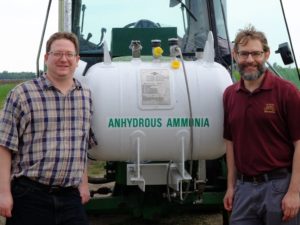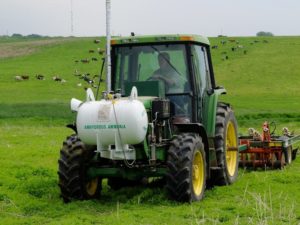University of Minnesota demonstrates efficient ammonia dual-fuel engine system
By Trevor Brown on June 28, 2019

This month, researchers at the University of Minnesota began successful field tests of their new ammonia engine, operating a heavy-duty tractor across farmland near Morris, MN, on a dual-fuel blend of 70% diesel and 30% ammonia.
The project is part of the university’s multidisciplinary ammonia research program, which includes the Wind-to-Ammonia demonstration plant that has been operating since July 2013 in Morris, MN, as well as the development of chemical separation technologies to improve the efficiency and affordability of small-scale Haber-Bosch, and techno-economic studies to optimize distributed ammonia energy systems. Articles about each of these projects can be found by browsing the Ammonia Energy archive for the University of Minnesota.
Taken together, the University of Minnesota’s ammonia research programs aim simply “to reduce the carbon footprint of agriculture.”

Funding for this engine project was awarded in 2016, as we reported at the time in the article “Displacing Diesel Fuel with Carbon-Free Anhydrous Ammonia.” The project was entitled “Clean Vehicles Fueled by Hydrogen from Renewable Ammonia,” and it focused on the development of “a novel technical solution to converting ammonia to hydrogen through catalytic decomposition.”
Last week, Minnesota Public Radio (MPR) News published the first in-depth article describing the technology and its progress from the lab to field tests, including interviews with many of the team responsible for its successful development thus far.
On this tractor, the fertilizer has become the fuel. It’s running on a blend of 70 percent diesel and 30 percent ammonia …
“It’s amazing to see it working. I’m excited to continue doing some of this research and refining this system,” said Will Northrop, director of the U of M’s Thomas E. Murphy Engine Laboratory in Minneapolis.
Northrop has spent months working on this technology in the lab … He and his colleagues are confident the system will eventually be able to replace at least half of the diesel fuel that typically powers a tractor, cutting back on the harmful greenhouse gas emissions that have long been a byproduct of agricultural production.
“Essentially, you’re cutting 50 percent of the carbon emissions from the engine, so that’s really a huge advantage,” said Northrop. “It’s something that you can’t really do with any other technology like engine efficiency improvements or other interventions.”
MPR News, Can fertilizer fuel greener tractors?, 06/19/19

While this month’s field tests were performed using a 70:30 blend of diesel and ammonia, earlier iterations of the engine system were tested in the Murphy Engine Research Lab using up to 50% ammonia (fuel-mix ratios are given according to energy content, on a lower heating value (LHV) basis).
The optimization of the tractor’s fuel mix represents a significant part of the team’s research challenge: reducing the greenhouse gas emissions associated with diesel fuel, without creating new environmental problems, like increased NOx or unburnt ammonia emissions, and without losing fuel efficiency.
The University of Minnesota’s dual-fuel system reclaims waste heat from the engine, and converts this to chemical energy by using it to crack some of the ammonia fuel. ‘Cracking’ or breaking apart the ammonia molecule (NH3) produces hydrogen fuel from the ammonia; the reaction is endothermic, consuming lots of energy. By powering this reaction with engine heat, this dual-fuel system turns waste energy into fuel energy, increasing the system’s efficiency.
That efficient fuel conversion using waste engine heat is the breakthrough technology that makes it all work. In theory, ammonia could replace 90 percent of the diesel fuel that’s typically used to run a tractor, but that might not be practical without emitting some ammonia in the exhaust, and since ammonia is toxic, safety is a primary concern.
“We need to be able to have a catalyst system that’s efficient enough to turn the ammonia back into hydrogen so that we can burn all the ammonia and get all of that fuel energy out of it before it reaches the exhaust,” said [University of Minnesota graduate student Seamus] Kane.
The ammonia system works most efficiently when the engine is working hard, generating a lot of heat and efficiently turning ammonia to hydrogen.
MPR News, Can fertilizer fuel greener tractors?, 06/19/19
The amount of energy reclaimed by using waste heat to crack ammonia could be significant. According to a 2017 analysis published by CSIRO of the Round-trip Efficiency of Ammonia as a Renewable Energy Transportation Media, the energy content (LHV) of ammonia is 5.17 MWh per metric ton if used as a direct fuel, but 5.91 MWh per metric ton if cracked to hydrogen. The cracking reaction adds 0.75 MWh per metric ton of ammonia, increasing the fuel’s energy content by roughly 15%.
The University of Minnesota’s internal combustion engine system is not designed to crack all of its ammonia fuel into hydrogen, however, but only about one quarter to one third of it. The exact proportion of ammonia fuel cracked to hydrogen varies according to engine operation, increasing at higher speeds and engine loads.
Technical data from the experimental lab phase will be published in the coming months, when the team presents its results at the ASME Internal Combustion Engines Fall Conference, October 20-23 in Chicago, IL.
Now that the research team has successfully demonstrated the engine in field operations, the university’s technology transfer department will presumably begin work to support its commercialization.
The challenge of any new technology is making the leap from experimental to everyday use.
Northrop said developing the ammonia engine and making it efficient was a challenge, but it’s a relatively simple system to install on a diesel engine, and one major farm equipment manufacturer has already expressed interest in the new ammonia engine technology.
“I think we’re well along the path to commercialization of the system,” he said. “I think that within a year so, we could have a commercial system on the market if there was a good opportunity to sell it.”
MPR News, Can fertilizer fuel greener tractors?, 06/19/19